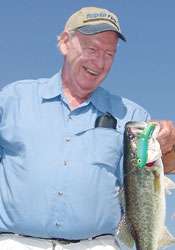
LAKEPORT, Fla. — On spectacular late spring mornings such as this, lines often are long for checkout in Beck’s Store, as anglers buy fuel, ice, food and tackle in preparation for a day pursuing bass and crappie on Lake Okeechobee. Launch ramps at nearby Harney Pond Canal typically are busy, too.
But on this particular day, the ramps are deserted. The store is empty. In fact, empty shelves at Beck’s are being left that way, said Sam Griffin, who lives nearby. That’s because for this part of Glades County, Lake Okeechobee might as well not even exist.
“The canal dries up a quarter-mile before it reaches the channel,” said Griffin, a local fishing guide and lure maker who grew up on the lake and knows it as well as anyone.
At 10.3 feet above sea level, the “Big O” is 3 to 4 feet lower than it should be in spring at the end of the dry season. That not only denies anglers access through Harney Pond Canal, but prevents them from fishing such famous areas as North Shore, Monkey Box and Moonshine Bay.
Still, that’s considerably better than the record low of 8.82 feet recorded in July 2007. Then, anglers were confined mostly to the mouth of the Kissimmee River on the north end and the Clewiston area on the south.
“You could fish the Rim Canal, pits off the canal and the ship channel that was dug out into open water from Clewiston,” Griffin said. “I’d see 25 boats fishing that channel. A lot of fish were caught and are still being caught on the riprap side of the canal.”
Like dozens of other anglers, Griffin and two friends forsake Harney Pond Canal and Beck’s on this spring morning and find another launch area. They fish Bricefind Pass, catching and releasing 25 bass, most in the 1 1/2- to 3-pound range. One considerably larger fish throws the bait at boatside.
“What bothers me is that we’re not seeing any little fish,” Griffin explained. “These are nice bass, but where are the little ones?”
The Florida native is afraid he already knows the answer.
As Okeechobee recovers from the record low of 2007, it still is reeling from the consequences of catastrophic high waters. They first blew in with the hurricanes of 2004 and 2005. Wicked winds and waves pulverized vast stands of shoreline vegetation. Storm surges churned up shallow bottoms, devastating grasses.
In the aftermath, water levels remained high and dirty, with few plants to filter out the sediment. For months, Moonshine Bay was one of the only productive areas on the massive fishery. Poor water quality and loss of habitat, Griffin fears, might have greatly reduced the spawn in 2006 and maybe even in 2007 — before the bottom fell out, sending the much beleaguered lake on its way to record low levels.
Theoretically, lower water will allow the aquatic grasses and other vegetation to flourish again, and when the lake refills, it will filter sediment and provide abundant habitat for bass, crappie and other fish.
But with a weather pattern that seems much more prone to extremes — drought one year and hurricanes the next — and the U.S. Army Corps of Engineers, which manages the lake, forced to juggle water levels in the midst of this new unpredictability, who knows what the next few years, or even months, might hold?
Diagnosis for the future health of Okeechobee is questionable at best, as it is for the Everglades, which depends on the Big O’s water.
In early May, the Corps announced that it intends to strive for a “safe” level of 12 1/2 to 15 1/2 feet above sea level. That would keep the lake about a foot lower on average than it has been in the past.
First, though, Okeechobee must rise another 2 feet just to get to that minimum level. And at press time, that does not appear likely to happen without another extreme weather event.
| For more great stories and the latest bass fishing news, subscribe to BASS Times. Call 877-BASS-USA to order today. |

